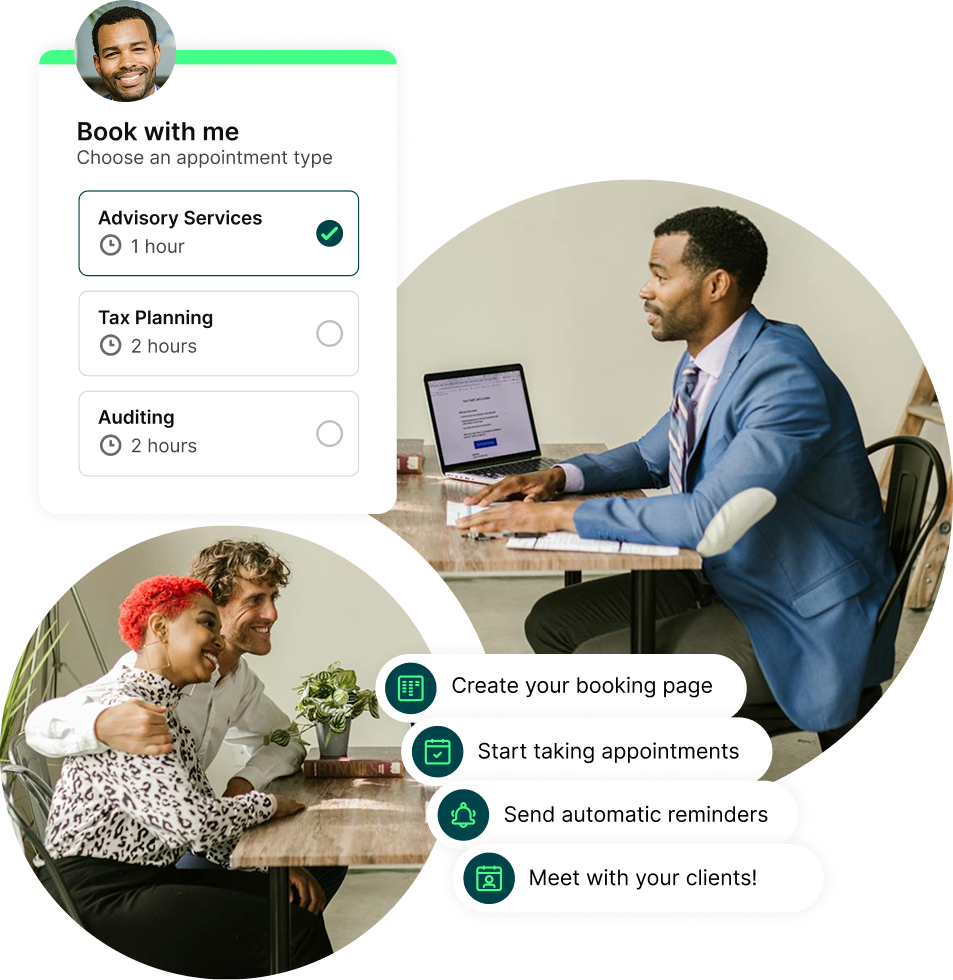How to Start a Bookkeeping Business in 9 Steps
Here are 9 steps you need to follow to start a bookkeeping business with confidence.

Lena Hartwell

Contents
- Step 1: Research your market and target audience
- Step 2: Map out your financials
- Step 3: Develop a marketing strategy
- Step 4: Get certified to stand out
- Step 5: Master bookkeeping software
- Step 6: Handle legal requirements
- Step 7: Protect your business with insurance
- Step 8: Define your services and pricing
- Step 9: Streamline client management
- Ready to build your bookkeeping business?
Ready to book more meetings?

Are you thinking about launching your own bookkeeping business? There’s never been a better time. As more companies look to streamline operations and cut costs, demand for outsourced bookkeeping is soaring. In fact, the global bookkeeping services market is projected to grow from $50.62 billion in 2025 to over $106.9 billion by 2033, expanding at a steady CAGR of 9.8%.
But how do you get started? This guide will walk you through the essential steps to launch a bookkeeping business that’s set up for success.
Let’s jump right in!
Step 1: Research your market and target audience
Before diving in, it’s crucial to understand who you want to serve. Are you targeting small businesses, freelancers, or specific industries like e-commerce, healthcare, or hospitality? Each niche has unique bookkeeping needs, so identifying your ideal clients helps tailor your services and marketing efforts effectively.
Conducting surveys or interviews can provide valuable insights into the pain points and preferences of your target audience, allowing you to refine your offerings. Additionally, analyzing competitors within your chosen niche can reveal gaps in the market that you can capitalize on, ensuring that your services stand out.
Step 2: Map out your financials
Next, estimate your startup costs and ongoing expenses. Think about software subscriptions, marketing budgets, insurance, and any certifications you might pursue. Then, project your revenue based on your pricing model and expected client volume.
Having clear financial projections will keep you focused and help you make informed decisions as you scale your small business. It’s also wise to create a cash flow statement to anticipate any potential shortfalls and ensure you have enough liquidity to cover your expenses during lean months.
This proactive approach can help you avoid common pitfalls that new businesses face, such as running out of cash before reaching profitability.
Step 3: Develop a marketing strategy
Your business plan should also include how you’ll attract and retain clients. This could involve a mix of online tactics like social media and SEO, as well as offline strategies such as networking events and local partnerships.
|
📣 No clue how to market your business? Check out our guide on small business marketing—it's packed with practical strategies to help you get noticed. |
The key is to build visibility and trust in your community or niche market. Consider creating valuable content, such as blogs or webinars, that addresses common bookkeeping challenges faced by your target audience. This not only positions you as an expert in your field but also helps in building relationships with potential clients.
Additionally, as soon as you start working with clients, you should ask them for a review. Client testimonials help build credibility and attract more potential clients.
Step 4: Get certified to stand out
While certification isn’t mandatory, earning credentials like the Certified Bookkeeper (CB) designation from the American Institute of Professional Bookkeepers (AIPB) can boost your credibility. It signals to clients that you have the knowledge and professionalism to handle their finances accurately and securely.
Moreover, obtaining such certifications often requires ongoing education, which keeps you updated on the latest industry standards and practices. This commitment to continuous learning not only enhances your skill set but also demonstrates to potential clients that you are dedicated to providing the highest level of service.
Step 5: Master bookkeeping software
Being proficient in popular bookkeeping software is essential. QuickBooks, Xero, and FreshBooks are among the most widely used platforms. Familiarity with these tools not only streamlines your work but also makes you more attractive to clients who want their books managed efficiently.
Additionally, many of these software programs offer advanced features such as automated invoicing, expense tracking, and real-time financial reporting, which can significantly enhance your ability to provide timely insights to your clients.
Understanding how to leverage these features can set you apart from competitors and position you as a valuable asset in your clients' financial management processes.
Step 6: Handle legal requirements
Check your local regulations to find out what licenses or permits you need to legally operate a bookkeeping business in your area. Register your business name and obtain an Employer Identification Number (EIN) from the IRS to stay compliant and professional.
You should also consider consulting with a legal expert who specializes in small businesses to ensure that you are fully aware of any industry-specific regulations that may apply. This could include understanding tax obligations, labor laws if you plan to hire employees, and any local zoning laws that might affect where you can operate your business.
Step 7: Protect your business with insurance
Insurance is often overlooked, but vital. Professional liability insurance protects you if a client claims you made an error that caused financial loss, while general liability insurance covers other risks. Having the right coverage gives you peace of mind and builds client confidence. Furthermore, you might want to explore additional types of insurance, such as cyber liability insurance, especially if you handle sensitive financial data.
Step 8: Define your services and pricing
Bookkeeping covers a range of tasks. You might handle financial reporting, accounts payable and receivable, payroll processing, or tax preparation assistance. Offering a clear menu of services helps clients understand what you provide and allows you to tailor packages that fit their budgets.
Pricing is also an important consideration. You can charge an hourly rate, fixed monthly fees, or offer packaged deals based on the complexity and volume of work. Research what competitors charge in your area and consider your experience level when setting rates. Transparent pricing builds trust and helps avoid surprises down the line.
Step 9: Streamline client management
Finally, you should consider investing in quality software to manage your leads and clients. At a minimum, get a customer relationship management (CRM) tool to track client communications, appointments, and service history.
In addition, consider investing in a scheduling tool to manage client meetings. Scheduling software for financial services, like YouCanBookMe (YCBM), lets clients book appointments directly into your calendar, eliminating the back-and-forth and making it easy to stay on top of meetings. Using YCBM, you can even take payments from clients prior to the meeting.
Some other tools you should look into:
- Proposal software
- Project management tools
- E-signature platforms
Ready to build your bookkeeping business?
If you’re serious about becoming a bookkeeper, now’s the time to take the leap. With the right foundation—skills, systems, and strategy—you can build a business that not only supports others financially but gives you the freedom to work on your own terms.
As you embark on your journey to start a successful bookkeeping business, remember that efficiency and client satisfaction are key. With YouCanBookMe, you can enhance your client's experience by simplifying the scheduling process.
Create your free booking page now!
FAQ
How much does it cost to start a bookkeeping business?
Startup costs for a bookkeeping business typically range from $1,000 to $5,000. This includes expenses like bookkeeping software (e.g., QuickBooks or Xero), business registration, insurance, marketing, and basic office equipment. If you pursue certification (like the AIPB or NACPB), factor in exam fees and study materials as well. Going fully remote can significantly reduce overhead, especially if you’re working from home and using cloud-based tools.
How to start a bookkeeping business with no experience?
You can start by learning the fundamentals through online courses or certification programs. Platforms like Coursera, LinkedIn Learning, and the AIPB offer beginner-friendly training in bookkeeping principles and software tools. Volunteering or taking on small freelance projects is a great way to gain hands-on experience. Focus on mastering one or two popular tools (e.g., QuickBooks, Xero) and build your credibility with testimonials, even from pro bono clients. Over time, you can scale up your expertise and client base.
How much per hour does a bookkeeper charge?
Rates vary depending on experience, services offered, and location. On average, freelance bookkeepers in the U.S. charge between $60 and $100 per hour. Certified or highly experienced professionals may command rates of $150 or more. Alternatively, many bookkeepers offer monthly packages (e.g., $300–$800/month) based on the complexity of a client’s needs.
Subscribe to our newsletter
Get productivity tips, news, articles and resources.
Written by
Lena Hartwell
Lena Hartwell writes about small business, offering practical tips and insights for anyone looking to start or grow their own venture from scratch.



